4 Marine litter and microplastics
Marine litter is a global problem that transcends national borders and spreads between sea areas. Plastic litter of every size and shape, from large objects to microplastics and nanoplastics, has been carried to every part of the world’s marine and coastal waters. Plastics in the sea have negative impacts on marine animals, biodiversity, ecosystems, fisheries, maritime transport, outdoor recreation, tourism and local communities. Plastic pollution is a potential threat to both food security and food safety. A UN report published in 2014 estimated that plastic waste in the oceans causes damage equivalent to more than USD 13 billion a year. A report prepared for the World Economic Forum has estimated that there will be more plastic than fish (by weight) in the oceans by 2050 unless significant action is taken. This estimate is tentative, but there is broad global agreement about the severity of the problem. Under the first target of UN Sustainable Development Goal 14 on the oceans, UN member states have agreed to prevent and significantly reduce marine debris by 2025.
This chapter discusses the distribution, quantities, fate and effects of plastics in the marine environment, and its sources and measures and instruments to deal with the problem at national, regional and global level. Land-based sources and waste management policy in general will be treated more fully in a white paper on waste management policy and the circular economy to be published later in the spring parliamentary session 2017. The measures proposed by the Government as part of international cooperation to combat marine litter are further discussed in the white paper on the place of the oceans in Norway’s foreign and development policy.
4.1 Distribution and quantities of marine litter and microplastics in the oceans
Marine litter includes all items of waste that end up on the shoreline or in the sea. Globally, plastics make up about 80 % of all marine litter. In 2010, annual inputs of plastics to the oceans were estimated at between 4.8 and 12.7 million tonnes. Global inputs of plastics to the oceans are rising rapidly.
Estimates of the distribution of plastic waste in the marine environment vary widely. Figures that are often quoted are that 70 % ends up on the seabed, 15 % on the shoreline and 15 % at the surface and in the water column. Other estimates suggest that an even higher proportion ends up on the seabed. Concentrations of plastic litter are often far higher on the shoreline than in the sea. Litter will end up in different areas depending on where it is released, ocean current patterns and whether it floats or sinks. The density and buoyancy of litter may change as it degrades and is colonised by marine organisms, so that litter such as plastic bottles may sink to the bottom.
Plastics are very useful because they are so durable, but this also means that they cause serious and long-lasting environmental problems when they end up in the environment. For example, it takes 450 years for a plastic bottle and 600 years for a fishing line to break down in the sea. During degradation, plastics break down into smaller and smaller fragments and eventually to microplastics (particles 1 mm to 5 mm in diameter) and then nanoplastics (less than 1 mm in diameter). The term microplastics is often used to cover all particles less than 5 mm in diameter, i.e. both microplastics and nanoplastics. No figures are available for the quantities of nanoplastics in the oceans or how much is ultimately completely degraded to inorganic compounds. Degradation proceeds most rapidly in areas such as the shoreline, where plastics are scoured against rocks and sand and are exposed to sunlight and bacteria. On the seabed and in sediments, degradation is extremely slow because temperatures are low and there is a lack of ultraviolet radiation and oxygen. It is uncertain whether plastics in the deepest parts of the oceans break down at all. Extreme weather events, flooding and natural disasters result in an increase in inputs of marine litter.
Plastic litter and microplastics are transported over long distances by ocean currents and can be found far from their sources. Marine litter has spread even to the most undisturbed areas where there is very little human activity, for example parts of the Arctic and remote, uninhabited tropical islands. Plastic bags and other waste have been found at a depth of 2500 metres in the Fram Strait in the Arctic, in concentrations similar to those in deep waters off the city of Lisbon. The Earth’s rotation, wind patterns and ocean currents result in the formation of ocean gyres, which are large rotating current systems. Plastics, microplastics and other waste accumulate in these areas. The largest gyre is in the Pacific Ocean and covers an area of more than 1.4 million km2. Relatively dense patches of waste can be found floating on the surface within the gyres, but most of the plastics are in the form of small particles floating on the surface and in the water column. The number of particles is estimated at more than 200 000 per km2, corresponding to less than one microplastic particle per m2. Plastics in the surface water are estimated to make up less than 1 % of the total quantity of plastics in the oceans. An investigation of microplastics in the ice in the Arctic showed a higher concentration than in the most polluted gyres, probably because microplastics become more concentrated in the ice when the water freezes.
Norway has been monitoring and reporting beach litter under the OSPAR Convention for the Protection of the Marine Environment of the North-East Atlantic since 2011. There are currently five monitoring sites on the coast of mainland Norway and two in Svalbard. Most of the waste that has been registered consists of fishing lines, nets and pieces of net, and rope. Both older records (from before the OSPAR method was developed) from the island of Været west of Trondheim, and records from all the OSPAR beaches since 2011, show that more than 70 % of the objects found are of plastic. There are generally high levels of waste on the beaches, but no indication of any significant change in quantities in the last few years.
Litter has been observed in 25 % of the video transects of the seabed recorded by the MAREANO programme in the Norwegian Sea and the Barents Sea – Lofoten area. These observations indicate that the average quantity of litter is around 200 kg per km2. However, almost 10 tonnes per km2 has been found locally near the coast. Particularly large quantities of litter have been observed in coastal waters just west of Ålesund. Most of the litter in this area can be traced back to the fishing industry, and includes heavy objects such as lost fishing gear, wires and cables, and an ‘unspecified’ category that probably also includes fisheries-related objects. Litter accumulates in marine valleys and narrow canyons. Most litter is found at depths of 200 – 300 metres, but increasing quantities are also being recorded at depths of 1100 – 1400 metres. Figure 4.1 shows the distribution of litter in different marine landscapes.
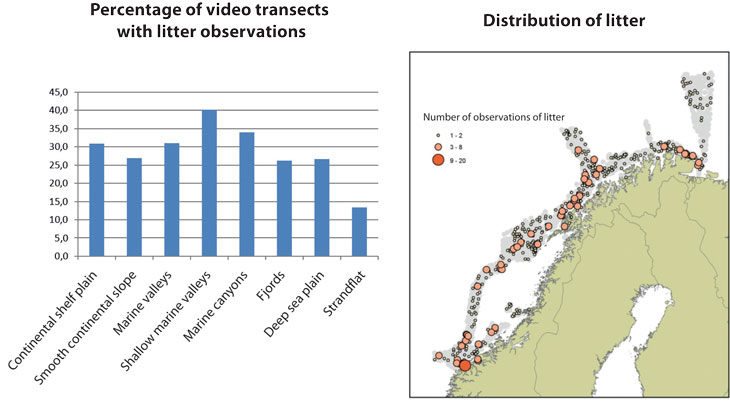
Figure 4.1 Left: Percentage of video transects with litter observations in different marine landscapes. Right: geographical distribution of litter recorded by the MAREANO programme.
Source Institute of Marine Research
4.2 Impacts of marine litter and microplastics
In 2001, a UN report estimated that about 1 million seabirds, 100 000 marine mammals and unknown numbers of fish and other animals were being injured or killed by marine debris every year. The figures for 2017 are likely to be much higher. Animals can mistake fragments of plastic for food, or become entangled in fishing nets and rope. As a result, they can suffer external or internal injuries and infections, or be strangled or starve to death. According to a report published by the UN in 2016, more than 800 marine species are known to be negatively affected by marine plastic litter. Seabirds, fish, marine mammals and sea turtles are species groups that are particularly badly affected. Living organisms can be dispersed by rafting from one continent to another on plastic litter, thus resulting in the spread of invasive alien species and pathogenic bacteria and viruses. Marine litter reduces people’s enjoyment of the seashore and has a negative impact on outdoor recreation and tourism. In some areas, damage to fishing gear and litter that becomes entangled in fishing nets is also a problem. Collisions with larger items of litter may cause damage to vessels, engine shutdown or a loss of steering. This may also be caused by ropes and fishing gear becoming entangled in propellers, and smaller fragments of plastic entering engine cooling systems.
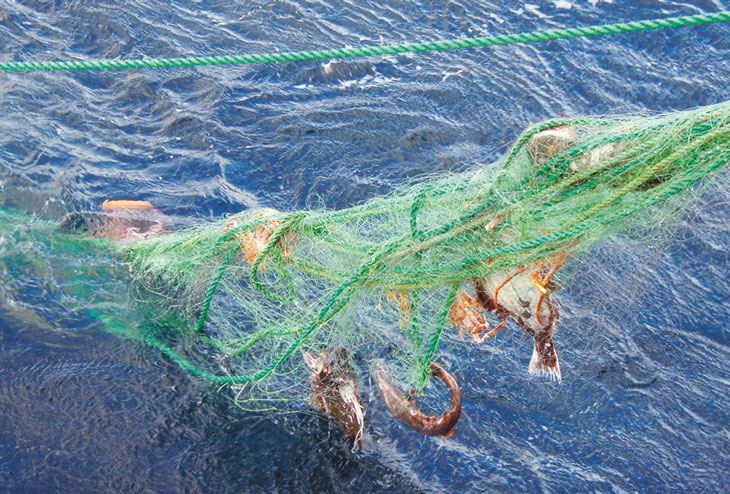
Figure 4.2 Lost fishing gear being hauled on board during a retrieval operation.
Photo: Directorate of Fisheries
Every year, large quantities of gill nets and other fishing gear are lost during commercial fishing operations. Lost fishing gear, pots and traps left on the seabed continue to catch fish and other marine animals (this is known as ‘ghost fishing’), resulting in unregistered fish mortality and a significant harvest. This is a waste of resources and can be a threat to vulnerable and endangered species. Lost fishing gear and other litter can become entangled in corals or damage seabed habitats in other ways. The loss of fishing gear also represents an economic loss. Where the water depth is less than 50 – 100 metres, the fishing efficiency of lost gill nets generally declines quite rapidly because of fouling by marine organisms and water movement. In deeper water, gill nets may continue to fish for much longer. Ghost fishing has been shown to continue for seven years off the coast of Senja island in North Norway. Lost fishing gear may also end up as microplastics when it is finally broken down. Parts of fishing gear and other plastic materials that are beached at an early stage of degradation break down into smaller and smaller fragments and eventually into microplastics.
Plastics and microplastics have been found in a wide variety of marine organisms at different trophic levels in marine food chains. Plastic litter has been recorded in the stomachs of marine mammals, seabirds and many species of fish (see Figure 4.3). Researchers have found microplastics in organisms including lobsters, squids and octopuses, crabs and molluscs, and zooplankton, which in turn are food for many other organisms. People may ingest microplastics when they consume seafood species that are eaten whole. Studies have shown that levels of microplastics in cultivated mussels and oysters in the North Sea can be considerably reduced by keeping the animals in clean water for three days.
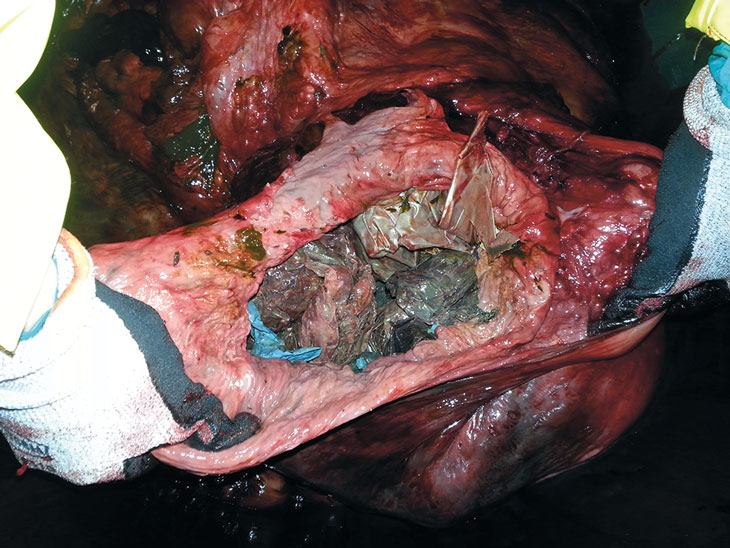
Figure 4.3 In February 2017, a Cuvier’s beaked whale that became beached on the island of Sotra in Hordaland was found to have 30 plastic bags in its stomach.
Photo: University of Bergen
Microplastics can injure and in the worst case kill marine organisms. In molluscs, it has been shown that nanoplastics can be absorbed into the blood system and tissue/cells, and can cause an inflammatory response. One study has shown that microplastics from mussels fed to crabs were transferred to the crabs, and the microparticles were subsequently found in crab haemolymph (circulatory fluid), gills and ovaries. Some plastics also contain hazardous substances. Because they have a large surface area relative to their volume, microplastic particles can also absorb significant amounts of organic pollutants from seawater. Thus, in addition to being harmful in themselves, microplastics may add to the harm caused by hazardous substances and play a part in bioaccumulation of hazardous substances in food chains.
So far, little is known about the impacts of plastics and microplastics on whole ecosystems and food chains. There is no evidence indicating that plastics and microplastics in seafood constitute a health risk, but the level of uncertainty is high. The European Food Safety Authority (EFSA) considers the smallest plastic particles, nanoplastics, to be of great concern as regards food safety because they can cross cell membranes.
4.3 Sources of marine litter
It is commonly assumed that 80 % of plastic litter in the world’s oceans comes from land-based sources, and 20 % from sea-based sources such as the fisheries and shipping. However, this is a very rough average for the world as a whole and is largely based on registration of plastic litter on beaches. Little data is available for surface water and the seabed. The proportions of litter derived from land-based and sea-based sources also vary widely between sea areas and regions. Further information on sources of microplastics will be presented in the forthcoming white paper on waste management policy and the circular economy.
Data from beach clean-up organised in Norway shows that most litter on beaches in the southern part of the country is from land-based sources such as households, industry, construction and agriculture, while the proportion of litter from the fisheries and other ocean-based sources tends to be higher further north (see Figure 4.4). Discarded leisure craft are also a source of marine litter. Sea-based sources include the fisheries, shipping, petroleum-related activities, ports and aquaculture. Marine litter on beaches in Svalbard consists largely of plastic litter from fishing fleets in various countries.
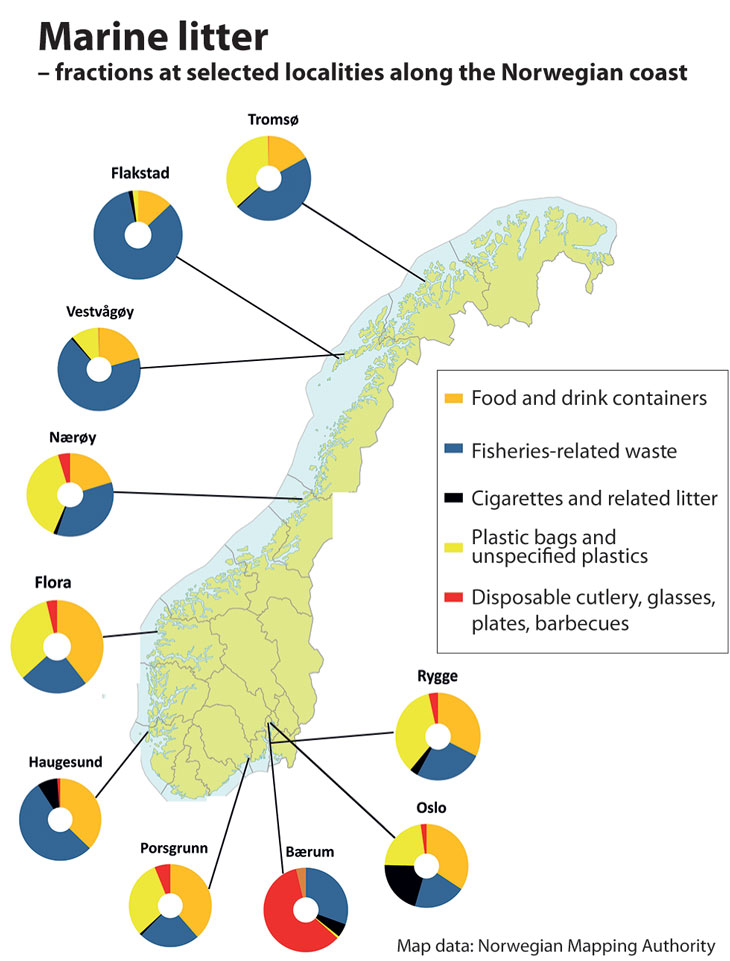
Figure 4.4 Proportions of different fractions of marine litter collected at selected localities in 2011. The very high proportion of disposable cutlery and similar items recorded at the locality in Bærum is explained by an event that had been held there shortly before.
Source Bo Eide, Tromsø municipality
The organisation Hold Norge Rent (Keep Norway Beautiful) organises a national beach clean-up campaign every year. In 2016, 77 % of the items found were made of plastics. Figure 4.5 shows the ten largest fractions of plastic litter by number of items.
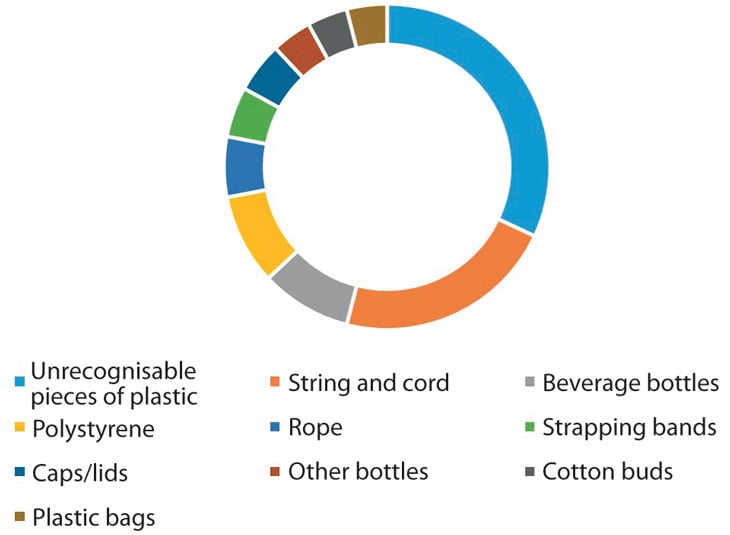
Figure 4.5 The ten largest fractions of plastic litter found during national beach clean-up campaign in Norway in 2016 (shares by number of items).
Source Hold Norge Rent
The mapping and monitoring programme for the Norwegian seabed, MAREANO, also collects data on marine litter. It has been confirmed that more than half the litter observed on the seabed during surveys is from fisheries activities (see Figure 4.6).
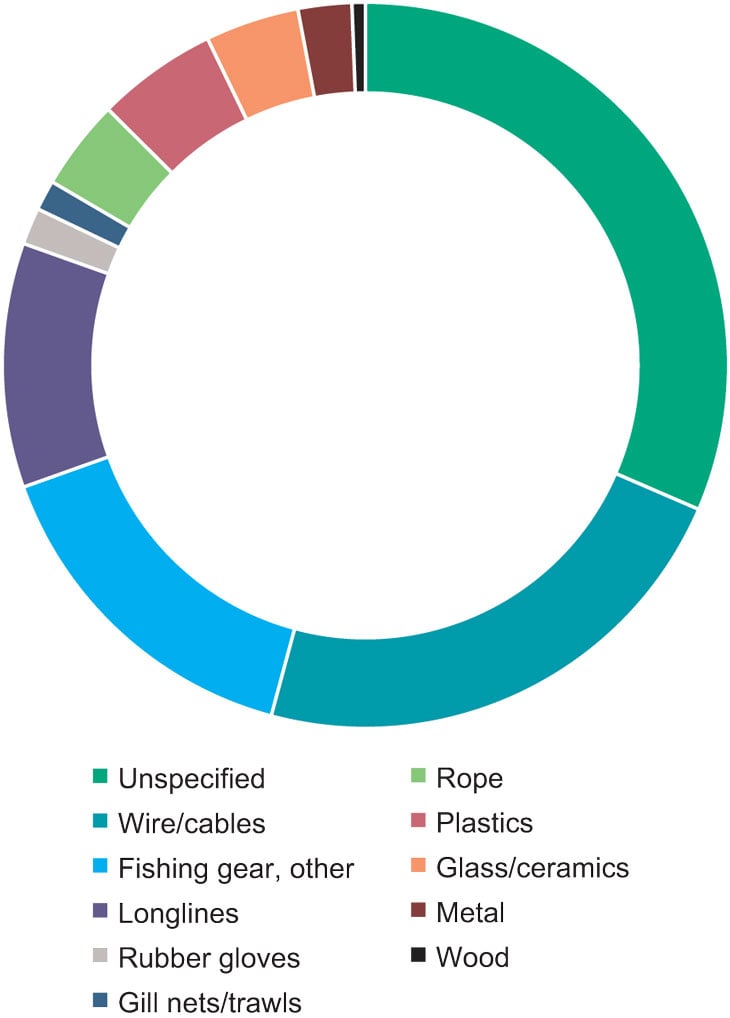
Figure 4.6 Types of litter observed on the seabed during MAREANO surveys in the Norwegian Sea and the Barents Sea – Lofoten area.
Source Institute of Marine Research
Modern fishing nets are made of various types of synthetic fibres, which degrade very slowly. It is estimated that in the european fisheries more than 33 000 nets a year are lost because of poor weather conditions, ocean currents and equipment failure. Norway has a good system for reporting of losses of fishing gear by the commercial fisheries, which is combined with a retrieval programme. However, there is some underreporting, and losses of nets, traps and pots and other equipment during recreational fishing have not so far been registered. The fisheries authorities estimate that annual losses of fishing gear are at least equivalent to the amount removed by the retrieval programme.
Abandoned mussel cultivation facilities along the Norwegian coast are another source of marine litter. In particular, they can be a navigation hazard, since rope from the facilities may become entangled in ship propellers. Ropes and other litter from the facilities can be difficult to see or detect on radar.
4.4 Mapping and monitoring
To gain an understanding of the scale of the marine litter problem and monitor trends in the quantities and types of marine litter, and thus be able to take appropriate action, it is essential to use a consistent methodology for quantifying the amount of litter and to develop time series of relevant data. Through OSPAR, Norway is taking part in international cooperation to monitor marine litter in accordance with agreed objectives and indicators. Beach litter is monitored in line with the OSPAR indicator at seven selected Norwegian beaches. The monitoring system for the marine management plans includes beach litter as an indicator for the Barents Sea – Lofoten area and plastic litter in fulmar stomachs as an indicator for the North Sea – Skagerrak area.
Since 2010, the annual ecosystem surveys in the Barents Sea carried out by the Institute of Marine Research and the Russian marine research institute PINRO (Knipovich Polar Research Institute of Marine Fisheries and Oceanography) have registered an increase in the amount of plastic litter caught as a bycatch in pelagic and benthic trawls.
In order to establish scientifically sound mapping and monitoring systems for microplastics in the marine environment, internationally agreed definitions, standardised quantitative methods and regionally suitable indicators are needed. Under JPI Oceans, a number of European countries are taking coordinated action to develop a common standard for analysing and mapping levels of microplastics and to investigate the impacts of microplastics on the marine environment and seafood. A similar system is needed for nanoplastics, but will be even more challenging to establish.
Indicators also need to be established for mapping and monitoring microplastics, for use both in the monitoring system under Norway’s marine management plans and in international cooperation on environmental monitoring, including the OSPAR system.
Textbox 4.1 Plastic litter in fulmar stomachs
OSPAR’s long-term goal is that less than 10 % of fulmars analysed should have more than 0.1 g of plastic in their stomachs, and this was included in the set of indicators for the North Sea – Skagerrak management plan in 2013. Fulmars in the North Sea area were investigated in 2015, and it was found that 95 % of them had plastic litter in their stomachs, and 67 % of beached birds had more than 0.1 g of plastic in their stomachs. Moreover, 34 % of fulmars taken as a bycatch in the fisheries also had more than 0.1 g of plastic in their stomachs. The quantity of plastic litter in fulmar stomachs shows a clearly declining trend northwards in the North-east Atlantic.
4.5 Goals and instruments
The first target under Sustainable Development Goal 14 is to prevent and significantly reduce marine pollution of all kinds, in particular from land-based activities, including marine debris and nutrient pollution, by 2025. Under OSPAR’s Marine Litter Regional Action Plan, Norway has adopted the goal of reducing inputs of litter that have negative impacts on coastal waters, the sea surface, the water column or the seabed.
Norway’s goals for marine litter in the three marine management plans are not identical, but their meaning is essentially the same. For the Barents Sea – Lofoten area, the goal is that ‘litter and other environmental damage caused by waste will be avoided’. For the North Sea – Skagerrak area, the goal is that ‘inputs of litter that have negative impacts on coastal waters, the sea surface, the water column or the seabed will be reduced.’ For the Norwegian Sea, the goal is that ‘litter and other environmental damage caused by releases and waste from activities in the Norwegian Sea will be avoided.’ These goals are not considered to have been achieved. The goals for marine litter in the different management plans need to be updated and coordinated. Marine litter also needs to be monitored more closely so that it is possible to improve assessments of status, trends and progress towards goals.
The Pollution Control Act states that littering is prohibited, and this applies both on land and at sea. Sound waste management is of crucial importance in preventing and reducing marine litter. Under the Pollution Control Act, municipalities are responsible for collecting and treating household waste, while business and industry are responsible for proper handling and treatment of their waste. Most municipalities now organise separate collection of various waste fractions, including plastic packaging. Extended producer responsibility applies to several waste types, including packaging. This approach means that producers are responsible for the products they sell throughout their life cycle, even after they have been discarded as waste. Any waste treatment facility that may cause pollution is required to hold a permit from the environmental authorities. The municipalities are also responsible for waste water treatment and treatment of sewage sludge.
To prevent littering, municipalities are required to provide waste receptacles at excursion spots and other heavily used areas where people are likely to discard waste, and arrange for them to be emptied. The same applies to anyone who runs a sales outlet where waste is likely to be discarded.
Before summer 2017, the Government will publish a white paper on waste policy and the circular economy. This will include a further account of how it intends to follow up the recommendations from the Norwegian Environment Agency for dealing with marine litter and microplastics, which were presented to the Ministry of Climate and Environment in 2016.
Textbox 4.2 The environmental authorities and marine litter
The Ministry of Climate and Environment has the overall responsibility for the marine environment and for providing the framework to ensure appropriate handling of waste and minimise damage to people and the environment. The Norwegian Environment Agency provides the Ministry with technical advice, conducts analyses and proposes measures for achieving Norway’s environmental targets, is responsible for inspection and enforcement, and takes part in Nordic, regional and international cooperation on marine litter. The Norwegian Polar Institute is an advisory body for the Norwegian authorities on polar matters, and is building up knowledge about marine litter and microplastics in the Arctic through mapping, research and monitoring activities and Arctic cooperation, and disseminating this knowledge internationally. The Environment Agency and the Polar Institute also implement measures to deal with marine litter and manage grant schemes.
The Storting has requested the Government to put forward a proposal with a view to prohibiting the use of microplastics in cosmetic and body care products. The Norwegian Environment Agency has carried out an assessment of possible measures to deal with the most important land-based sources of the spread of microplastics in Norway. These include measures to reduce the spread of microplastics from the following sources: car tyres and road dust, rubber granules from artificial turf, maintenance of boats and ships, textiles and plastic pellets. The Environment Agency has been asked to assess several of these measures further.
Cosmetic and body care products are a relatively minor source of the spread of microplastics, and there are few producers of cosmetics in Norway, with only a small share of the market. The Norwegian Environment Agency therefore recommends that the Norwegian authorities should support international regulation of microplastics in cosmetic and body care products rather than introducing a national prohibition.
At the same time, several countries are now considering national prohibitions on these products. For example, Sweden is considering a national ban on microplastics in ‘rinse-off’ cosmetics. Cosmetics are not believed to be a major source of microplastics in Sweden either, and the Swedish proposal refers to national and international work that is being done to phase out the use of microplastics in cosmetic products.
The Ministry of Climate and Environment will consider the Swedish proposal for national regulation of microplastics in cosmetic products more closely and will initiate a dialogue with the Swedish authorities to obtain more information about how their national prohibition will be designed. A ban on the use of microplastics in cosmetic and body care products in Norway could be introduced in the form of regulations under existing legislation.
The Ministry will also consider the possibility of cooperation with other Nordic countries to encourage the EU to introduce a prohibition on the use of microplastics in cosmetic and body care products. An EU-wide prohibition would have a much greater effect than a national one, and would also apply in Norway. Marine litter and microplastics have high priority on the agenda during Norway’s presidency of the Nordic Council of Ministers in 2017. In this connection, the environmental authorities will maintain contact with the other Nordic countries about work that is in progress and the possibility of further cooperation in this area.
Norway regulates discharges of waste from ships through the Regulations on environmental safety for ships and mobile offshore units under the Ship Safety and Security Act. The Norwegian taxation system also provides economic incentives to deliver waste from ships to an appropriate facility. A waste management fee that covers waste reception and treatment is payable regardless of whether waste is delivered to a reception facility in port. The waste management fee is not levied on leisure craft and fishing vessels that do not pay harbour dues.
Under the Marine Resources Act, fishermen are required to search for lost fishing gear and report losses to the Norwegian Coast Guard if gear is not retrieved. The Directorate of Fisheries organises an annual retrieval programme for lost fishing gear. Retrieval operations take place mainly along the coast between Ålesund and Kirkenes, with the main focus on areas from the Lofoten Islands and northwards. Since this programme started in the early 1980s, about 20 000 gill nets (almost 600 km) and large amounts of other fishing gear have been retrieved. From 2010, the retrieval programme was expanded by 40 %, and the quantities retrieved have increased considerably. From 2010 to 2016, the programme retrieved 6 600 gill nets, 185 000 metres of longlining gear, more than 300 king crab pots, 70 000 metres of rope, 47 000 metres of wire, trawls, purse seines, Danish seines and much more (see Figure 4.7). Most of the retrieved fishing gear is taken ashore to be cleaned, sorted and delivered for recycling.
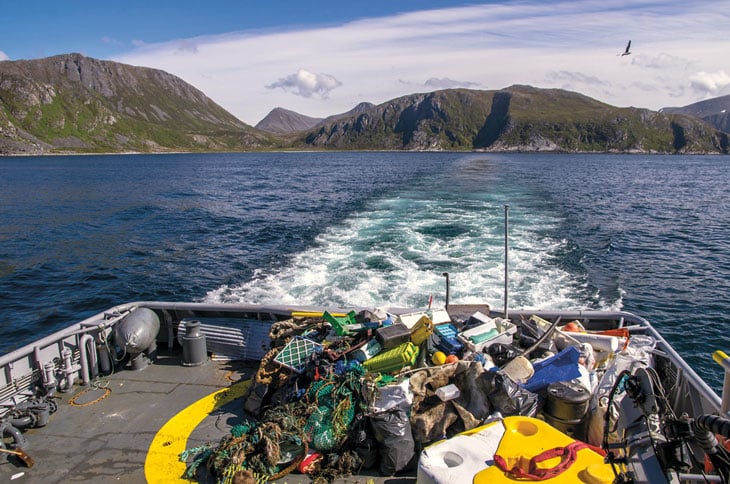
Figure 4.7 Coast Guard vessel with a cargo of retrieved marine litter, Hansnes, Troms.
Photo: Bo Eide
The retrieval programme has reduced the risk of snagging and more losses of fishing gear, reduced the waste of seafood resources, improved the reliability of data on fish stocks and reduced pressure on biodiversity. The duration of the programme and the length of the time series of data on lost fishing gear is probably unrivalled anywhere in the world.
Through the Fishing for Litter project (see Box 4.3), the environmental authorities are gaining experience and knowledge as a basis for what may become a permanent system for fishing vessels to deliver marine litter they retrieve at sea free of charge in ports. The Norwegian Environment Agency is reviewing the possibility of introducing such a system for fishing vessels and other vessels.
Plastics and other waste from the fisheries, and to some extent the aquaculture industry, are a source of marine litter. The Norwegian Environment Agency is reviewing a proposal for a producer responsibility scheme for the fisheries and aquaculture industry.
Textbox 4.3 Fishing for Litter
Norway’s Fishing for Litter initiative is a two-year trial project (2016 – 2017) commissioned by the Norwegian Environment Agency, and is being carried out by the consultancy firm SALT Lofoten. Its objective is to gather information on the amounts and types of marine litter that fishing vessels pick up during normal fishing operations, and about the best ways of organising delivery in ports and, where possible, recycling. At the same time, the project contributes to clean-up. The fishing vessels that are taking part are provided with large robust bags for any litter caught in trawls and other fishing gear during fishing operations. They can deliver the bags in port, where the waste is sorted, registered and handled. Any suitable waste is delivered to the company Norsk fiskeriretur for recycling. In 2016, 28 ocean-going vessels and three ports (Tromsø, Ålesund and Egersund) took part in the project on a voluntary basis. A total of 48 tonnes (48 183 kg) of waste was delivered in these three ports in 2016. Of this, 37 tonnes was fisheries-related waste that was suitable for recycling. The rest included all other types of waste, including fisheries-related waste that was not suitable for recycling. The fishing vessels made a total of 44 deliveries of waste.
The project is part of Norway’s action to implement OSPAR’s Marine Litter Regional Action Plan, and is expanding knowledge about the types of marine litter in the sea and about recycling of litter.
In addition to clean-up, work is in progress on various solutions for finding lost gear more quickly and on reducing the effects of ghost fishing by using different materials in gill nets and traps and pots. In 2017, the Directorate of Fisheries is launching a new mobile app for recreational fisheries that will make it possible for people to report lost fishing gear and thus further reduce ghost fishing.
After a succession of bankruptcies in the mussel farming industry, the Directorate of Fisheries and the Norwegian Coastal Administration have been removing a number of mussel cultivation facilities. A deposit system has been established for such facilities established after 2007 to ensure that they are removed/cleaned up in the event of bankruptcy. In 2015, 22 facilities were removed in Nordland county, and in 2016, 26 – 30 tonnes of waste was removed from five facilities. Removal of abandoned mussel cultivation facilities also improves maritime safety.
At one stage, large quantities of non-rechargeable batteries were used in the Norwegian Coastal Administration’s beacons and light buoys. The Coastal Administration has received reports of finds of batteries dumped in the sea near some of these. The fjords of Møre og Romsdal county were surveyed in 2016 to find dumped batteries. Video filming of the seabed at 29 localities showed batteries or possible batteries at six localities, all in the same area. The Coastal Administration will remove these batteries in 2017, and carry out a survey in other coastal areas.
Large-scale clean-up operations will continue to be needed to deal with marine litter. Normally, beach clean-up operations are the most cost-effective because concentrations of litter are high and beaches are more easily accessible than the open sea. Beach clean-up should be given highest priority in areas where there are vulnerable habitats or other where other assets such as important recreational areas are most seriously damaged by litter. Retrieval of lost fishing gear from areas of the seabed where such litter accumulates has also proved to be effective. Clean-up operations in surface waters may be appropriate in ports and other heavily polluted areas, but it is not realistic to expect clean-up operations in surface waters far out to sea to be cost-effective.
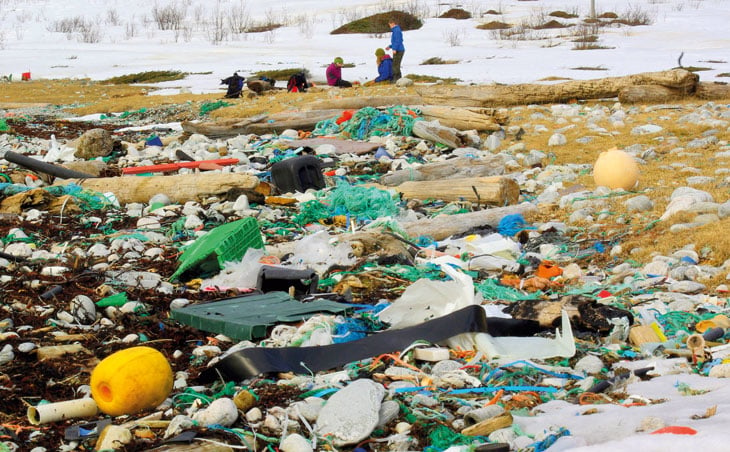
Figure 4.8 Marine litter on the beach at Skulsfjord, Troms.
Photo: Bo Eide
In addition to the clean-up campaigns organised by central and local authorities, voluntary work is of key importance for practical clean-up activities, awareness-raising and communicating knowledge. Through a grant scheme run by the Norwegian Environment Agency, support is provided every year for projects to prevent and clean up marine litter. In 2016, more than 70 applications were received and NOK 15 million was allocated to 22 projects. In 2017, the funding available was increased to NOK 35 million. Some of the funding has gone to Hold Norge Rent (see Box 4.4), which administers a system for refunding expenses incurred by volunteers for transport and delivery of litter collected from beaches. Businesses, private foundations and others also provide substantial grant funding and practical assistance with clean-up operations.
Textbox 4.4 Keeping Norway clean
Hold Norge Rent (Keep Norway Beautiful) is a non-profit foundation which in 2016 had 34 companies, organisations and public-sector agencies as members. The board includes members of waste management and recovery companies, industry organisations, energy companies and outdoor recreation organisations. The foundation also cooperates with the Norwegian authorities. Its overall objective is to prevent marine and other litter and to involve volunteers in cleaning up litter and hazardous waste in Norway. In 2016, 18 500 volunteers were registered as taking part in the nationwide clean-up effort organised by Hold Norge Rent, and litter was cleared from a total of 869 km of shoreline. Other volunteers also take part in clean-up campaigns without being registered.
The Government intends to establish an oil spill preparedness and response and environmental centre in the Lofoten/Vesterålen region, which will also be involved in activities to combat marine litter. Ways in which the centre can work towards a cleaner marine environment by promoting knowledge, technology and methods for oil spill response and for dealing with marine litter are under review.
4.6 International cooperation
Marine litter is a global environmental problem that can only be dealt with through effective international cooperation. Ocean currents spread marine litter and microplastics all across the world. The largest inputs globally are from a handful of Asian countries with large populations where waste management systems are inadequate and consumption of plastics is high. Coastal states with large populations and fast-growing economies may also become major sources of marine litter if growth in consumption is not followed up with effective systems for preventing plastic litter. Improving waste management systems in these countries may be prove to be cost-effective. Many countries that are badly affected by marine litter have limited resources and are not major sources of litter. Norway is therefore giving high priority to international cooperation in this field. Further information on Norway’s international efforts to combat marine plastic waste is presented in the Government’s white paper on the place of the oceans in Norway’s foreign and development policy.
Norway has taken the initiative for global cooperation to combat marine litter through the UN system, particular through the UN Environment Assembly (UNEA), which is the UN’s highest-level decision-making body on the environment, and the UN Environment Programme (UN Environment). Norway proposed UNEA resolutions on marine litter and microplastics in 2014 and 2016, unified decided by 170 countries. Norway has also provided funding for implementation of the resolutions through UN Environment.
In response to the 2014 resolution (UNEA 1/6), a global peer-reviewed report was produced by a group of experts coordinated by UN Environment. The report gives an account of the best available knowledge on sources, effects and experience of action to deal with the problem. The report was presented in 2016 as a basis for the second resolution (UNEA 2/11), which was adopted in May 2016. The 2016 resolution contains recommendations on action and priorities for authorities, industry, civil society, regional and global commissions and other stakeholders. Among other things, it recommends regional cooperation through action plans for specific sea areas. On the basis of a proposal from Norway, it was decided to make an assessment of the effectiveness of international, regional and sub-regional governance strategies, approaches and regulatory frameworks for combating marine plastic litter and microplastics, and identifying possible gaps and options for addressing them. The assessment will be presented to the third session of UNEA in December 2017. One of its purposes is to identify the potential that lies in coordinating international processes more closely and expanding existing agreements, and to evaluate whether a new legally binding agreement should be developed to reduce inputs of plastics to the oceans. Norway will continue to press for progress in this area.
The International Convention for the Prevention of Pollution from Ships (MARPOL) under the International Maritime Organization (IMO) regulates discharges of garbage into the sea. It includes a general ban on discharging waste into the sea from ships. Waste from ships that is not incinerated on board must be delivered in port.
Action on marine litter and microplastics is a high priority in the regional cooperation between the countries around the North-East Atlantic on the marine environment under the OSPAR Convention, in which Norway plays an active part. In June 2014, OSPAR adopted its Marine Litter Regional Action Plan (see Box 4.5). Norway will seek to speed up progress in the implementation of the action plan.
Textbox 4.5 OSPAR
OSPAR’s Marine Litter Regional Action Plan includes action against litter from both sea-based and land-based sources, removal of litter, enhancing knowledge and awareness, and education and outreach.
OSPAR has previously established guidelines and systems for:
monitoring beach litter;
monitoring plastic particles in fulmar stomachs;
monitoring seabed litter;
fishing for litter initiatives (see Box 4.3).
The Norwegian authorities have so far started monitoring of beach litter, monitoring of plastic particles in fulmar stomachs and a fishing for litter project. In addition, Norway will make a special contribution to the following activities under OSPAR:
developing guidelines for best practices in waste management in the fisheries;
identifying areas where fishing gear that has been abandoned, lost or otherwise discarded tends to accumulate as a result of fishing activities, the underwater topography or patterns of ocean currents;
developing solutions for reducing inputs of litter, especially microplastics, to the oceans via waste water from land.
The Food and Agriculture Organization of the UN (FAO) has taken several initiatives to reduce losses of fishing gear from fishing vessels. FAO’s Committee on Fisheries is working on guidelines for the marking of fishing gear to facilitate retrieval and avoid ghost fishing. Norway has helped to keep this issue on the agenda, and has urged other countries to carry out retrieval campaigns.
In the last few years, Norway has also taken active steps to put marine litter and microplastics on the agenda of the Nordic Council of Ministers. Several cooperation projects have been carried out, and there is general Nordic agreement on the importance of this issue. During its presidency of the Nordic Council of Ministers in 2017, Norway has put lost fishing gear, ghost fishing, marine litter and microplastics even higher on the agenda. Strategic efforts will include closer dialogue at ministerial level in the Nordic region, initiatives for closer cooperation between the Nordic countries in regional and international processes, and specific Nordic projects on topics including microplastics in marine organisms and action against ghost fishing.
Norway will also assume a leading role through the Arctic Council to strengthen the knowledge base on marine litter and microplastics in the Arctic. This will provide an important basis for the next step, which would be to prepare a regional marine litter action plan to be adopted by the Arctic states.
On 2 December 2015, the European Commission presented its Circular Economy Package. This included proposals for a number of measures dealing with plastics and marine litter, which were also intended to address the target of reducing marine litter under Sustainable Development Goal 14.
4.7 Knowledge needs – marine litter and microplastics
Broad-based international cooperation is particularly important for developing scientific definitions of microplastics and standardised sampling and measurement techniques and indicators. These are needed for satisfactory monitoring of marine litter and microplastics in the Norwegian Sea. Monitoring should be initiated based on the OSPAR indicators that are already available.
There is also an urgent need for research on plastics in the oceans, including the distribution and quantities of plastics in the marine environment and living organisms, the spread and sources of plastics, and degradation under various kinds of realistic conditions in the shore zone and at sea. More knowledge is also needed on the impacts on marine organisms, biological production, biodiversity and ecosystems, food safety and human health.
In addition, more research and development is needed on effective, environmentally friendly ways of preventing marine litter and inputs of micro-plastics to the oceans, and of cleaning-up marine litter.